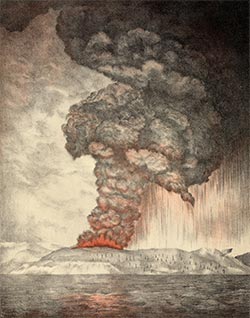Volcanoes: Razing and Renewing the Earth
The eruption of a volcano can bring devastation, death, and widespread destruction, sometimes obliterating mountaintops, islands, and towns. But that’s not the whole story. Volcanoes provide a fresh face for the Earth, coughing up rocks and minerals from deep inside the planet. These building materials give birth to new land and provide nutrients for plants to thrive. What are volcanoes and why do they erupt? Why do some volcanoes spew sky-high ash while others ooze rivers of red-hot lava? How well can volcanologists predict an eruption—and save the lives of the people who live nearby?
 |
|
|
Photo courtesy of Dreamstime. Hot lava splatters into the air and flows into a glowing orange river down the cinder cone of the Piton de la Fournaise volcano on Réunion Island. |
top: Photo courtesy of volunteer Janet Goto. Japan’s Mount Fuji is one of the most beautiful volcanoes in the world, with its classic symmetry and snowcapped cone. |
|
bottom: Photo courtesy of volunteer Marcelo Amaral Vieira Rosa. Mount Kilimanjaro, in Tanzania, is Africa’s most famous volcano. |
|
Volcanoes are good examples of the two sides of natural phenomena. When quiet, they are snowcapped beauties, surrounded by exotic landscapes created by lava. When active, the sound, fury, and fire are frightening in their power. Perhaps one of the best ways to understand a volcano is to relive one of the most astonishing eruptions in recorded history.
A Mountain Wakes UpOn May 20, 1883, after 200 years of peaceful slumber, one of the three close-knit volcanoes on the island of Krakatau, Indonesia, suddenly woke up. The mountain shuddered and smoked and then shot a cloud of ash and steam nearly 11 km (7 mi) high from its cratered summit. No one lived on the lushly forested island, fortunately. But people on passing ships and residents of the islands of Java and Sumatra felt, heard, smelled, and witnessed the awakening. Three months passed and the residents became used to the occasional outbursts. Visitors gathered to watch the volcano’s spectacular performance. Then, on August 26, the real show began, a deadly grand finale that no one expected. An escalating series of afternoon and evening blasts created shock waves that tossed up black ash and agitated the sea to extremes. The first of 18 tsunamis flooded nearby coasts. Five more explosions, starting at 5:30 a.m. the following morning, created a fresh onslaught of tsunamis and thick hails of searing hot rock and ash. Krakatau wasn’t finished. At 10:02 a.m., the biggest blast of all blew the island to bits. Within seconds, two-thirds of the mountainous land broke apart, the pieces scattering widely around. A cloud of black ash soared 50 km (30 mi) into the air. The sound of the explosion, the loudest sound in recorded history, traveled across the Indian Ocean. The shock waves would bounce to the opposite side of the globe and back again for five days, ringing the planet like a bell. One badly burned survivor named Johanna Beyerinck later told of her ordeal. After ash pushed up through the floorboards of her house “like a fountain,” her family fled for higher ground. Then, she recounted, “Thousands of tongues of fire lit up the surroundings; some only small tongues, some longer. As they disappeared they left a greenish light. Others quickly filled their place. On tops of the trees I saw flames. I heard a crack and noticed a sheet of fire right by me…I felt a heavy pressure, throwing me to the ground. Then it seemed as if all the air was being sucked away and I could not breathe. Large lumps cluttered down on my head, my back, and my arms.” After two days of darkness, the clouds finally cleared. Some 36,500 people had died, most of them washed away by the tsunamis. Over the next three years, the black ash cloud traveled around the world.
But death and destruction are never the whole story when it comes to volcanoes. The ash cloud created beautiful sunsets for three years, so beautiful that an artist in England felt compelled to capture them in thousands of color sketches. Firefighters in New York City mistook the red glow for burning buildings in the distance. Though the original island disappeared, milder explosions in the same location gave birth in 1927 to Anak Krakatau, meaning “child of Krakatau.” The baby volcano has since grown into an active but not dangerous adolescent. Three-peaked Krakatau didn’t stand alone. Like many volcanoes located near each other, it was part of a li |
This content has been re-published with permission from SEED. Copyright © 2025 Schlumberger Excellence in Education Development (SEED), Inc.



